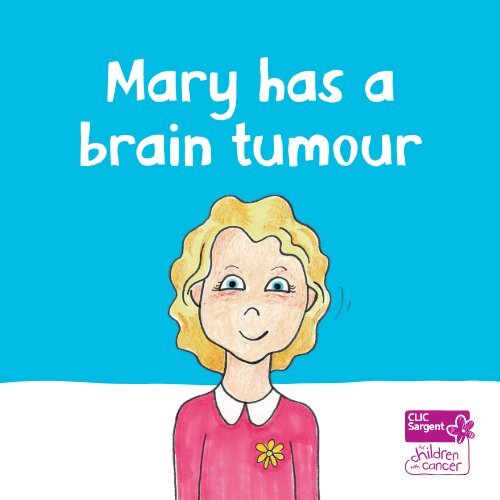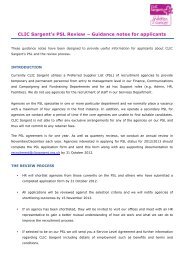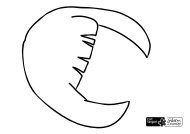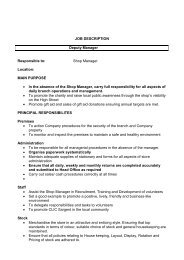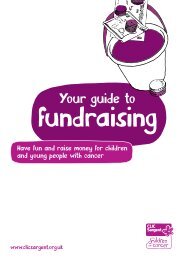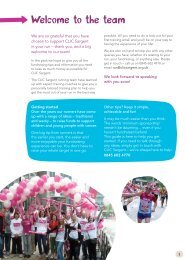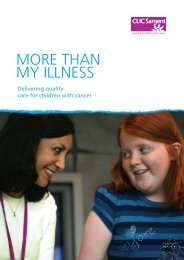Mary has a brain tumour - CLIC Sargent
Mary has a brain tumour - CLIC Sargent
Mary has a brain tumour - CLIC Sargent
- No tags were found...
You also want an ePaper? Increase the reach of your titles
YUMPU automatically turns print PDFs into web optimized ePapers that Google loves.
<strong>Mary</strong> <strong>has</strong> a<strong>brain</strong> <strong>tumour</strong>
<strong>Mary</strong> <strong>has</strong> a <strong>brain</strong> <strong>tumour</strong> is a storybook written especiallyfor parents and carers to read with children, to help themunderstand what cancer is and the treatment it involves.At the back of the book you will find a useful glossary of words youmay come across during your child’s treatment.<strong>CLIC</strong> <strong>Sargent</strong> is the UK’s leading cancercharity for children and young people, andtheir families. We provide clinical, practicaland emotional support to help them copewith cancer and get the most out of life.
<strong>Mary</strong> <strong>has</strong> a<strong>brain</strong> <strong>tumour</strong>By Victoria BartonMedical reviewer for this edition: Professor Richard Grundy,Children’s Brain Tumour Research Centre, University of NottinghamIllustration byTony HarrisThis book belongs to..............................................................................
This is <strong>Mary</strong>. She is five years old and lives with her mum,dad, brother Lewis and baby sister, Patsy. <strong>Mary</strong> <strong>has</strong> a dogcalled Pickles, and a rabbit called Flora.She enjoys lots of things like running, skipping and doingcartwheels, but most of all <strong>Mary</strong> likes to play with her friendSusie who <strong>has</strong> two kittens, Jack and Jill.1
For a few weeks <strong>Mary</strong> had been unwell. She felt very tiredand was a little bit grumpy. Sometimes she was sick whenshe got up in the morning and often she had bad headaches.Mum was worried so she took <strong>Mary</strong> to the doctor – he lookedin <strong>Mary</strong>’s eyes and checked her thoroughly and then he saidthat she needed to go to hospital straight away.2
The hospital doctor examined <strong>Mary</strong> again and saidthat she would need to have some tests, one ofthem was called a scan * .* Words in italics are explained under ‘What these words mean’ at the back of this book.3
The scan would take pictures of the inside of <strong>Mary</strong>’s head.<strong>Mary</strong> would need to lie very still inside the big tube that tookthe pictures, but it would not hurt at all. The scan would bequite noisy but she could listen to some music or a story.Soon after the scan, thedoctor saw <strong>Mary</strong>, andMum and Dad. He toldthem that <strong>Mary</strong> had alump in her head andthis was causing theheadaches and sickness.The lump was called a<strong>brain</strong> <strong>tumour</strong> and wasa type of cancer.5
“What is cancer?” <strong>Mary</strong> asked. The doctor explained that“Everyone’s body is made up of millions of tiny cells, so tiny thatyou cannot see them without amicroscope. These cells make updifferent things our bodies need -like blood, muscle or bone.Healthy cellsSometimes the cells start to divide up to make new cells tooquickly and do not do their job properly. Lots of damaged cellsare made and they stop the good cells from working properly.This is called cancer. Somecancers grow more quicklythan others.”Damaged cells6
“When the damaged cellsdo not know what theyshould do they begin tostick together to form alump, which is called a<strong>tumour</strong>.There are different types of <strong>brain</strong> <strong>tumour</strong>. Some are treatedwith surgery only, and others need to be treated withchemotherapy and radiotherapy as well.”7
The doctor said that <strong>Mary</strong> would need to have an operationto take the <strong>tumour</strong> out and she would need to stay inhospital. He explained that sometimes children find it difficultto talk or walk for a little while after an operation. If thishappened to <strong>Mary</strong> there would be specialists to help her.The doctor would find out what kind of <strong>tumour</strong> <strong>Mary</strong> hadand he would then tell her what treatment she would needto make sure the <strong>tumour</strong> stayed away.<strong>Mary</strong> was unhappy about staying in hospital, but there wereother children to play with on the ward and Mum and Dadtook it in turns to stay with her and look after Lewis and Patsy,Pickles and Flora.8
The next morning <strong>Mary</strong>was not allowed to haveanything to eat becauseshe was going to haveher operation. First of allanother doctor came tosee her. She was called ananaesthetist and her job wasto look after <strong>Mary</strong> and makesure she stayed fast asleepduring her operation. Mumand Dad would be with herwhen she went to sleep and when she woke up.10
Then another doctor came, he wascalled a neurosurgeon and he wasgoing to do her operation. <strong>Mary</strong>wanted to know what would happen.The neurosurgeon explained that hewould have to shave a little hair off<strong>Mary</strong>’s head when she was asleep sohe could see her head properly.<strong>Mary</strong> would have a big bandage onwhen she woke up and she might feel a bit tired and sore.He told her that she wouldwake up in another wardcalled Intensive Care.11
When the nurses came to take <strong>Mary</strong> for her operation shehad to put on a special gown with an opening at the back.She also had some magic cream put on the back of her hand.It made it go numb, so whenshe had a tube put in, it didn’thurt so much.12
The tube was used to give <strong>Mary</strong> the medicine she neededto make her sleep through the operation. <strong>Mary</strong>’s mum waswith her and she held her hand until the medicine made hergo to sleep.The next thing <strong>Mary</strong> knew was that she was lying in bed, withMum sitting by her on one side and Dad on the other. Therewere a lot of machines bleeping and she felt very tired so shewent back to sleep.Soon <strong>Mary</strong> was feeling better and she was able to sit up andhave something to eat. Mum and Dad were very proud ofher. The nurse came and said it was time to go back to herward so Mum, Dad and the nurse pushed <strong>Mary</strong>, in her bed,along the corridor.13
A week later the doctorcame to see <strong>Mary</strong>, Mumand Dad, and told <strong>Mary</strong>that she would need tohave chemotherapy and shemight need radiotherapy aswell. With the chemotherapysome would be tablets andsome would be medicinewhich would go througha central line. There aredifferent types of central line- a portacath and a Hickman line.14
Often the line is called a wiggly! The line is very usefulbecause, as well as giving medicines, it is used for takingblood tests. The doctor said that <strong>Mary</strong> would not be inhospital all thetime but she wouldneed another smalloperation to put thecentral line in. Firstshe could go homefor a while to get alittle bit stronger.15Hickman line
When <strong>Mary</strong> went home everybody made a fuss of her andbought her presents. Her brother Lewis was really pleased tosee her, but he felt a bit left out. Luckily Mum and Dad soonrealised this and he and Patsy were always included.Once the central line was in, <strong>Mary</strong> started her chemotherapy.She was usually weighed and measured when she came tothe hospital for treatment and a blood test was always takentoo. The doctor could then decide if <strong>Mary</strong> should have hertreatment that day or if she needed a blood transfusion. Thetransfusion helped <strong>Mary</strong> to have more energy and made herfeel better.When <strong>Mary</strong> had chemotherapy it was given through a dripattached to the wiggly line.16
The chemotherapy took a few days each time and she had tostay in hospital. Mum and Dad took it in turns to be with her,and sometimes Lewis and baby Patsy visited too. Every sooften <strong>Mary</strong> had to stay in hospital a little longer if she had atemperature, and Lewis and Patsy went to stay with Granny.<strong>Mary</strong> did not mind being on the ward as she made friendswith the other children. If she felt well enough the teachersand play specialists always had things she could do or make.At home <strong>Mary</strong> was given her medicine by Mum and Dad andthe community nurse came to take blood.19
After a few weeks of startingthe chemotherapy, <strong>Mary</strong>’shair started to fall out. Thedoctor had told her this wouldhappen and that it would growback once the treatment hadstopped. He also told her thatit wouldn’t hurt and, although<strong>Mary</strong> had not believed him,he was right.20
<strong>Mary</strong> saw other boys and girls in hospital without hair– some had wigs and some wore caps or scarves.<strong>Mary</strong> wore a hat. <strong>Mary</strong> and the other children oftentalked and played together.21
Sometimes <strong>Mary</strong> felt well enough to go to school for a littlewhile and see her friends. When she was not well enoughfor school Mrs Brown,a teacher, sometimescame and gave herlessons at home. <strong>Mary</strong>really enjoyed that.Mum said the lessonswould help her tokeep up with the workher friends were doingin school.22
One day <strong>Mary</strong> saw a boy called Joe come to the ward whowas not allowed to play with anyone. She was told that hehad come for some medicine to help stop him catchingchickenpox from his friend at school who had woken upone morning with spots all over his body. People who arehaving chemotherapy can be very unwell if they catchchickenpox, or other bugs. <strong>Mary</strong> thought it strange thatyou could catch chickenpox but that you couldnot catch cancer.People having chemotherapy can alsobecome unwell if they get infections in theirbloodstream, which is why <strong>Mary</strong>’s mum tookher temperature quite often.23
It took a long time to finish all the chemotherapy treatment,but at last it was finished. <strong>Mary</strong> had another scan and thenthe doctor said she would need to have radiotherapy.The doctor explained that radiotherapy was like having anX-ray or another scan. It would not hurt but <strong>Mary</strong> might feeltired or a bit sick so the doctor would give her medicineto help with this. Sometimes radiotherapy can make hairfall out too, but only on the part of the head where theradiotherapy <strong>has</strong> been given. Like when she had the scan,<strong>Mary</strong> would need to lie very still for a few minutes.24
A mask, a bit like a space helmet, would be made especiallyfor <strong>Mary</strong> to wear while she was lying still.Mum and the playspecialist madeup a game where<strong>Mary</strong> and Mumhad a special songthey both sang tothemselves. When thesong was finished itwould be time for thetreatment to stop.25
When the radiotherapy started, <strong>Mary</strong> had to lie on a narrowtable with a big machine above her that gave the treatment.She had to be in the room by herself while the machine wasworking but it was only for a minute or two and it did not hurtat all. Mum watched her on television and they could alwaystalk through an intercom.The radiotherapy sessions lasted for six weeks and the worstthing about it was that <strong>Mary</strong> got sore ears, just like sunburn.Towards the end of the treatment <strong>Mary</strong> felt very tired. Thedoctor had said this might happen and <strong>Mary</strong> got lots of rest.27
After some months <strong>Mary</strong> felt really well and the doctor toldher that she had finished all the treatment. In a while the linewould be taken out.28
The doctor said that <strong>Mary</strong> would need to continue to cometo the hospital for checkups, tests and scans to make sureshe was growing properly and keeping well.29
Lewis helped Mum and Dad to arrange a surprise party forwhen <strong>Mary</strong> finished her treatment. All her friendscame and although she wasnot quite well enough to docartwheels <strong>Mary</strong> had awonderful time. Thebiggest surprisewas a little kittenall of her own...30
What do you think she called him? Wiggly!31
What these words meanYou may hear lots of strange new words when you’re in hospital. Below weexplain what some of them mean. If you’re unsure about any others, just askyour doctor or nurse.ANAESTHETISTThis is a doctor who gives you a medicine that makes you really sleepy, sothat you fall asleep. You have an anaesthetic before an operation, so you cansleep right through it without feeling anything. Afterwards the doctors willwake you up.BLOOD TESTWhen a tiny sample of your blood is looked at to see how many red cells, whitecells and platelets you have (this is called a full blood count or FBC).BLOOD/PLATELET TRANSFUSIONWhen your blood count is low you may need extra blood to help you feel better.CANCERWhen the cells in your body become abnormal (bad) and continue to growon their own, out of control.32
What these words meanCHEMOTHERAPYA mixture of different medicines which treat cancer.HICKMAN LINEA long plastic tube inserted into one of the big veins (blood vessels) in yourbody, usually your neck. The end comes out through a small hole in the skinon your chest. This is inserted under general anaesthetic.NEUROSURGEONA doctor who specialises in operations on the <strong>brain</strong>.OPERATIONWhere you have some medicine called anaesthetic to make you go to sleepfor a while, then the doctors can have a look at your body without hurting you.PORTACATHA device, or bobble, is inserted under the skin near the armpit under generalanaesthetic and a very thin tube (the line) then runs under the skin to the mainvein in the neck. If treatment is given or blood taken, ‘magic cream’ is put onto the skin covering the bobble beforehand – to make it go numb so it will nothurt so much when the needle goes in.33
What these words meanRADIOTHERAPYIs where very special rays are pointed at the <strong>tumour</strong>. The job of the rays isto try to get rid of even the tiniest scrap of <strong>tumour</strong> that might be left afterthe operation and chemotherapy.SCANThis can be a CT scan, which is fairly quick, or a MRI scan which takes alonger time. It’s like an X-ray. The machine is very noisy but it gives a veryclear picture inside your body.THEATRE/OPERATING ROOMThis is where you will go if you need to have an operation. The room <strong>has</strong> lotsof equipment in it that helps doctors and nurses to keep you well.34
Do you have any questions,or need some help?<strong>CLIC</strong> <strong>Sargent</strong> is the UK’s leading cancer charity forchildren and young people, and their families. Weprovide clinical, practical and emotional support tohelp them cope with cancer and get the most outof life. Talk to your <strong>CLIC</strong> <strong>Sargent</strong> care professional,or call us on 0300 330 0803 and we’ll put you intouch with someone who can help.You can also visit our website atwww.clicsargent.org.ukor email us at info@clicsargent.org.ukPlease note that everyone’s experience will be different and may not follow the order outlined here. Services will differacross the UK. <strong>CLIC</strong> <strong>Sargent</strong> does not accept any responsibility for information and services provided by third parties,including those referred to or signposted to in this publication.We endeavour to ensure that the information provided is accurate and up-to-date at time of printing. <strong>CLIC</strong> <strong>Sargent</strong>cannot accept liability for any loss or damage resulting from any inaccuracy or omission in this publication. Informationin this publication should not be relied on in place of appropriate professional advice specific to your circumstances.www.clicsargent.org.ukRegistered charity number 1107328 and registered in Scotland (SC039857)35
Ref: SER014_14185Version: 3, October 2014Next planned review: 2017For information about the sources used to put thispublication together, or if you have any comments orqueries about it, please contact us on 0300 330 0803and ask to speak to the Information Manager.


